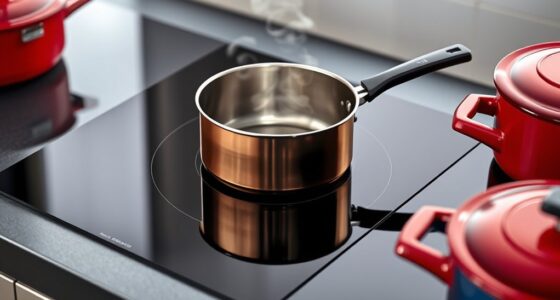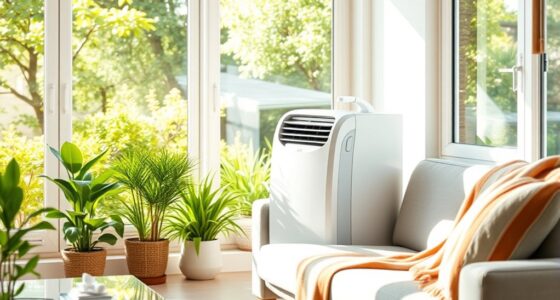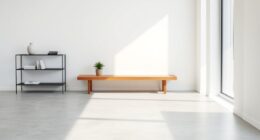Air purifiers can help reduce airborne allergens and particles, providing relief, but they’re not a complete solution. They won’t fix issues like poor ventilation, mold, or chemical off-gassing, which impact indoor air quality more deeply. Many models require ongoing maintenance and can be costly, especially for large spaces. To make an informed choice, consider their limitations and explore effective alternatives. If you keep going, you’ll discover essential tips to maximize your air quality investments.
Key Takeaways
- Air purifiers effectively remove airborne particles but do not address source issues like mold, moisture, or chemical off-gassing.
- Proper maintenance and filter replacement are essential; neglect reduces effectiveness and can lead to wasted money.
- They work best in small, single rooms and are less cost-effective for large spaces or multiple rooms.
- Relying solely on air purifiers ignores the importance of ventilation, cleaning, and fixing underlying pollution sources.
- High-end models can be expensive, and their benefits may be limited if root causes of allergies remain unaddressed.
Understanding What Air Purifiers Can and Cannot Do
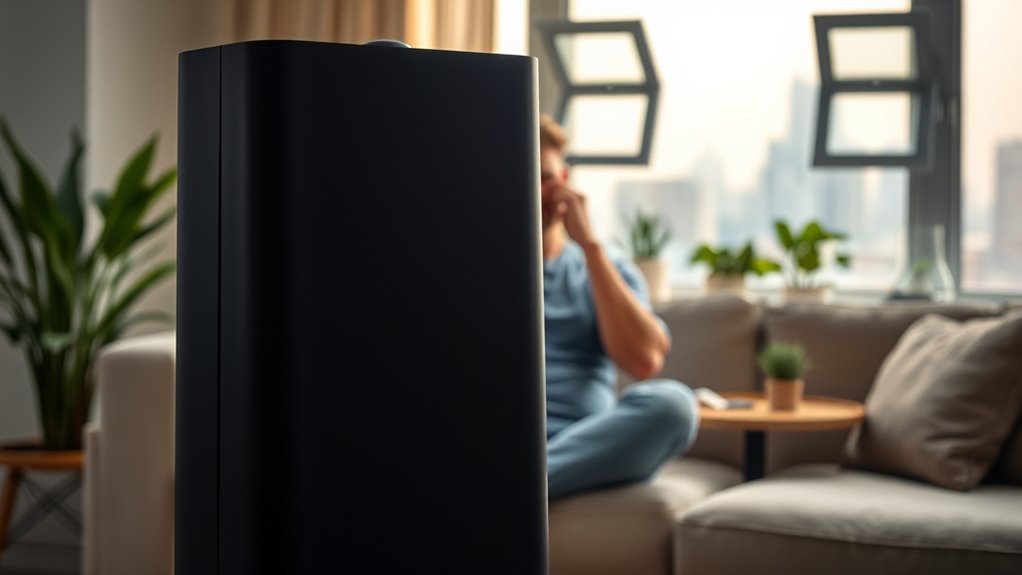
While air purifiers with HEPA filters can considerably improve indoor air quality by capturing airborne particles like dust, pollen, pet dander, mold spores, and some bacteria, they have limitations. HEPA filters are effective at reducing particulate matter but don’t address sources of pollution like poor ventilation, dampness, or chemical off-gassing. They also don’t remove gaseous pollutants such as VOCs unless equipped with activated carbon filters, which require regular filter replacement. Air purifiers mainly process air within a single room, so they’re less effective in larger spaces or multiple rooms. They do not kill viruses or bacteria directly, nor prevent germs from settling on surfaces. For better air quality, combining air purification with proper ventilation and surface cleaning remains essential. Additionally, understanding the limitations of air purifiers can help set realistic expectations for their role in improving indoor air quality. Recognizing the role of filtration technology in removing specific pollutants can further inform effective air quality strategies. Moreover, some models incorporate features like odor control to tackle smells, but these should not be solely relied upon for comprehensive air purification. Proper maintenance and understanding of their filter replacement requirements are crucial for optimal performance. Being aware of the limitations of filtration can help consumers make more informed choices about their air quality solutions.
The Limitations of Purifiers in Addressing Indoor Air Quality Root Causes
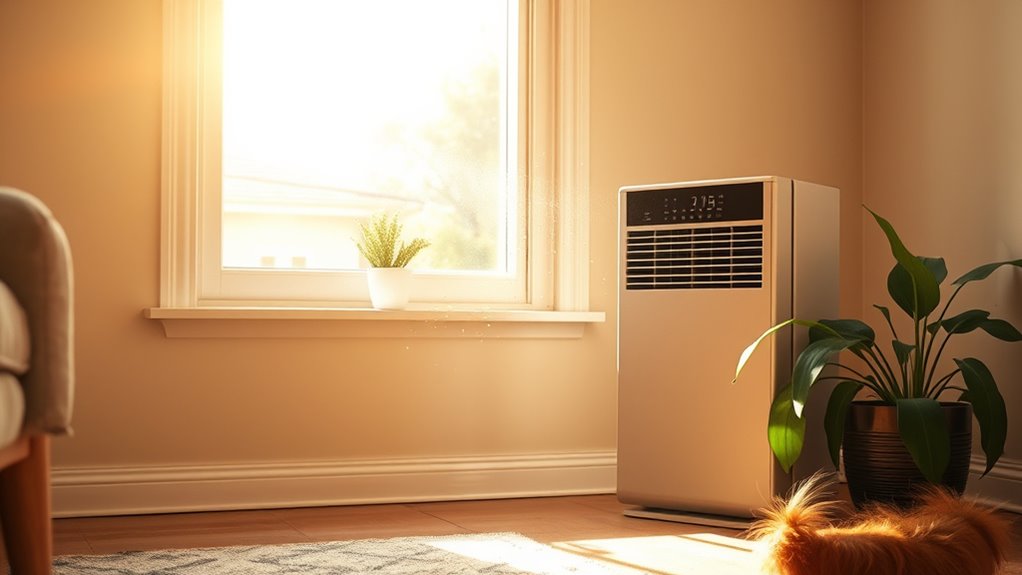
Air purifiers excel at capturing airborne particles, but they don’t tackle the root causes of poor indoor air quality. They can remove dust, pollen, and mold spores, but pollution sources like mold growth, chemical off-gassing, or excess humidity remain unaddressed. Without fixing these underlying issues—such as improving ventilation, reducing humidity levels, or maintaining the building—you won’t see lasting improvements. Relying solely on air purifiers ignores essential building maintenance and cleaning practices that target pollution sources at their origin. Addressing indoor air pollution sources is crucial for comprehensive improvement. The limitations of purifiers mean they offer only a partial solution. To truly improve indoor air quality, you need to address the root causes, or your efforts will be limited and temporary at best.
Effectiveness in Removing Different Types of Pollutants
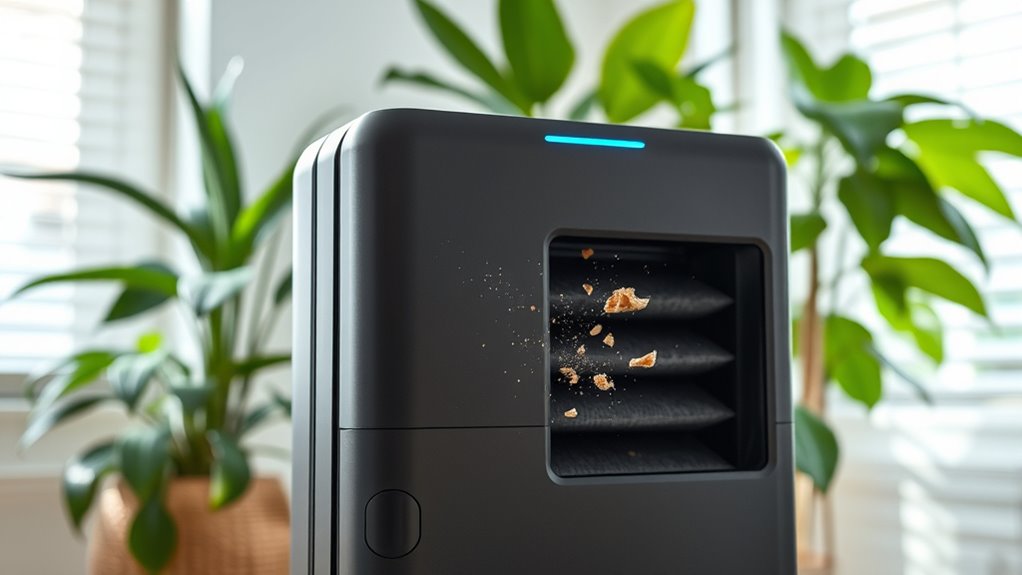
The effectiveness of air purifiers in removing different types of pollutants depends largely on the filters they use and how well they are maintained. HEPA filters excel at trapping airborne particles like pollen, dust mites, and bacteria, providing effective particle removal. Activated carbon filters absorb gases, odors, and VOCs, but their performance varies with filter thickness and chemical concentration. HEPA filters are particularly beneficial for allergy sufferers by reducing allergens such as pet dander and pollen. Here’s a quick overview:
| Filter Type | Targeted Pollutants | Limitations |
|---|---|---|
| HEPA filters | Particles, allergens, some bacteria | Limited gaseous pollutant removal |
| Activated carbon filters | VOCs, odors, gases | Less effective for biological contaminants |
| Both filters | Combined airborne particles & gases | Requires regular air purifier maintenance |
Proper maintenance and selecting the appropriate filter type are essential for ensuring optimal air quality, which can be improved through the use of advanced filter technology. Regularly replacing filters according to manufacturer recommendations helps maintain filter efficiency and ensures continuous pollutant removal.
Coverage Challenges and the Cost of Multiple Units
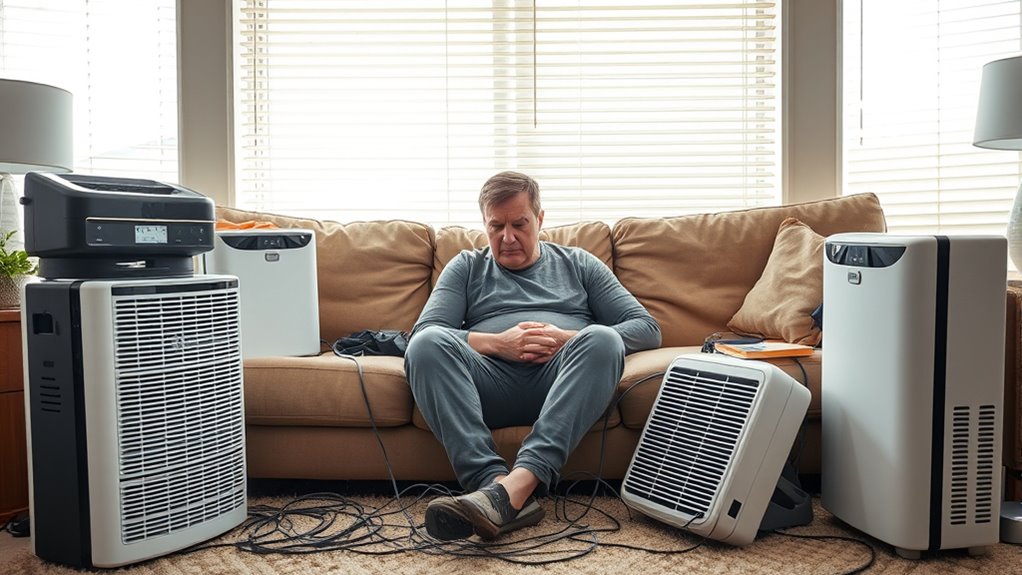
Covering large areas with air purifiers can be challenging because most units are designed for specific room sizes, typically between 150 and 400 square feet. To achieve large room purification, you’ll often need multiple units, which increases coverage challenges and maintenance efforts. The cost of air purifiers adds up quickly when purchasing several devices, especially since high-quality models and replacement filters can be expensive. Relying on multiple units to cover an entire home is often cost-prohibitive, making it difficult to address persistent indoor pollutants effectively. Additionally, operating several units increases noise levels and complicates ventilation system integration. This scattered approach can be inefficient and may not provide thorough coverage, leading many to consider alternative solutions for large space purification. Proper maintenance and filter replacement are essential for ensuring air purifiers work effectively over time. Moreover, integrating indoor air quality management strategies such as advanced filtration systems or heat pumps with air filtration capabilities can offer a more comprehensive and cost-effective solution. Recognizing the importance of unit placement and airflow can also improve the efficiency of your air purification efforts.
Noise Levels and User Experience

Even though many air purifiers are designed to improve indoor air quality, their noise levels can substantially impact your user experience. High noise levels, like 74 dB from models such as the Blueair 211, can cause sound disruption in quiet settings. Conversely, some modern units advertise quiet operation at around 25 dB, similar to a whisper, but actual performance varies with fan speed and room acoustics.
Many air purifiers are noisy, but adjustable fan speeds help balance air quality and comfort.
Consider these factors:
- Noise levels in product specifications help predict how loud the air purifier will be during operation.
- Higher fan speeds increase decibels (dB), potentially causing sleep interference or work distractions.
- Selecting a model with adjustable fan speed allows you to balance air purifier noise with your comfort, improving overall user experience.
- Understanding the noise levels associated with different models can help you choose one that minimizes disturbance during sleep or work.
- Awareness of noise mitigation features can further enhance user comfort, especially in sensitive environments.
- Additionally, some units incorporate soundproofing technologies to reduce overall noise output, which can be beneficial in quiet spaces.
- Research indicates that sound vibrations from certain appliances can influence not only comfort but also physiological responses, making noise control a key factor in user satisfaction.
- Being aware of the ambient noise in your environment can help you select an air purifier that blends seamlessly into your space without causing distraction.
Common Misconceptions About Air Purifier Performance
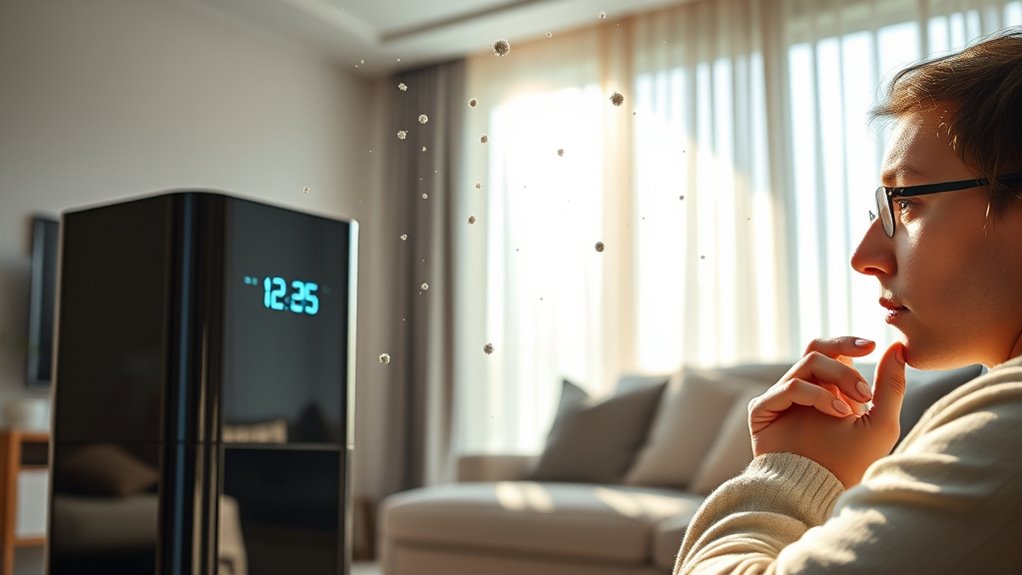
Many people assume that buying a high-end air purifier guarantees it will effectively remove all allergens and pollutants as advertised. However, misconceptions about air purifier performance often lead to disappointment. Manufacturer claims can exaggerate effectiveness, making you believe the device will fully eliminate allergens, viruses, or odors. In reality, filtering capabilities vary widely depending on factors like room size, placement, and maintenance, impacting real-world results. Industry standards like CADR ratings offer some guidance but don’t promise complete pollutant removal or improved air quality under all conditions. Some purifiers even produce ozone or harmful byproducts, contradicting safety claims. Understanding these limitations helps you set realistic expectations and choose a device suited to your specific needs, rather than relying solely on marketing hype. Additionally, filter replacement frequency plays a crucial role in maintaining optimal performance over time.
Weighing the Benefits Against Ongoing Expenses
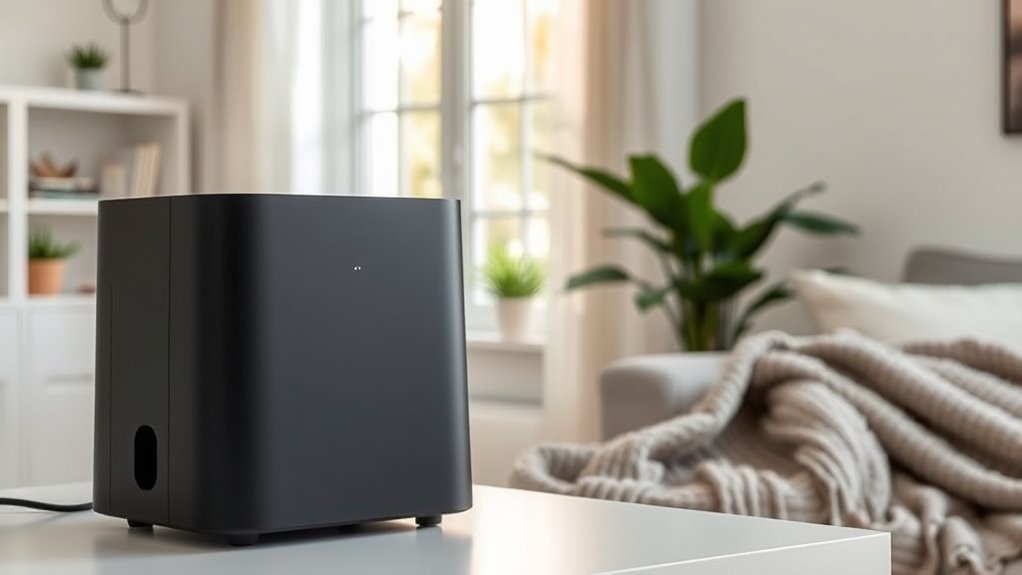
While air purifiers can substantially improve indoor air quality by reducing allergens and pollutants, it’s important to think about the ongoing costs involved.
- Filter replacements, which can range from $20 to over $200 every 3–6 months, markedly add to ongoing expenses.
- High-quality models like Dyson or Blueair often require a hefty initial investment of $400–$799, plus maintenance costs.
- In large spaces, performance decline means you might need multiple units, increasing total air purifier costs.
Before committing, do a cost-benefit analysis considering filter replacement costs and long-term maintenance costs. For some households, especially in well-ventilated or low-pollution areas, these ongoing expenses may outweigh the health benefits, making it a less viable long-term investment.
When Addressing Ventilation and Building Practices Is More Effective
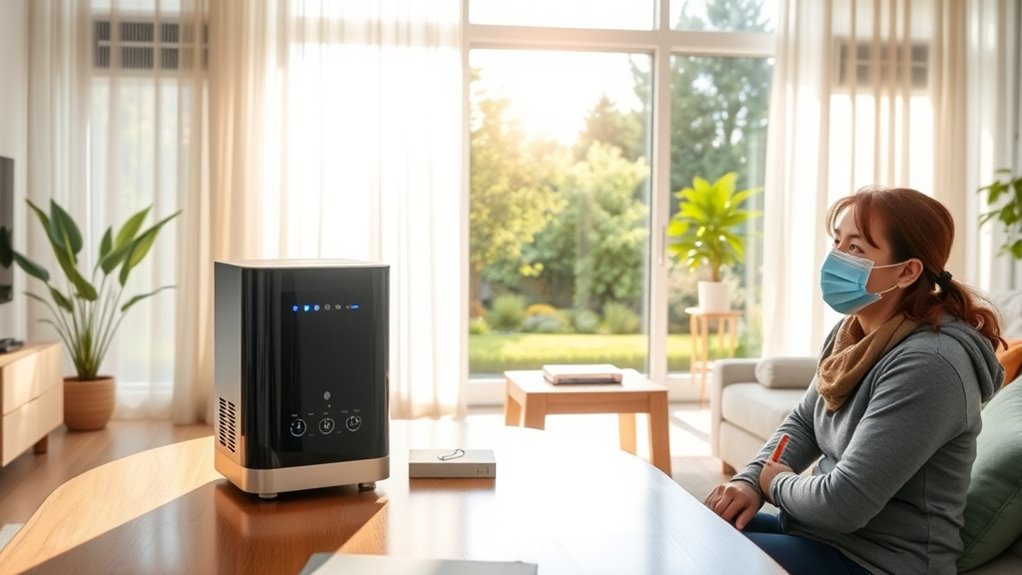
Focusing solely on air purifiers can lead to ongoing expenses that add up over time, but addressing ventilation and building practices often provides a more effective solution. Improving ventilation through opening windows or installing exhaust fans enhances indoor air quality by increasing air exchange and diluting indoor pollutants. Good building practices, like moisture control and mold prevention, target the root sources of contamination that purifiers can’t eliminate. Upgrading HVAC systems with high-quality filters and maintaining them regularly boosts airflow and reduces pollutants efficiently. Addressing leaks, insulation issues, and source control minimizes moisture and mold, providing long-term health benefits. When you focus on proper ventilation and building practices, you often rely less on costly air purifiers and create a healthier indoor environment naturally.
Frequently Asked Questions
Do Air Purifiers Really Make a Difference for Allergies?
You wonder if air purifiers really help with allergies. They can make a difference by trapping airborne allergens like pollen, pet dander, and mold spores, especially with HEPA filters. However, they don’t remove allergens hiding in carpets or bedding. For the best results, match the purifier to your room size, keep filters clean, and address other allergen sources. Used correctly, air purifiers can ease allergy symptoms.
What Do Doctors Say About Air Purifiers?
Doctors often see air purifiers as a gentle boost for allergy and asthma care. They note that while purifiers can help reduce airborne allergens like pollen and pet dander, they aren’t magic solutions. HEPA filters trap many particles, but won’t eliminate germs on surfaces. Be cautious about ionizers producing ozone, which may irritate your lungs. For best results, combine purifiers with good ventilation, cleaning, and allergen control.
Is There a Downside to Air Purifiers?
You should know that air purifiers can have downsides. They might produce ozone, which irritates your lungs, especially if you have respiratory issues. Maintenance costs can add up, and many models only cover small areas. They don’t eliminate germs on surfaces or airborne viruses outside the filter. Plus, noisy units can disturb your sleep or quiet space, so weigh these factors before investing in one.
Why Are Air Purifiers a Waste of Money?
Did you know that many air purifiers only remove about 50-70% of airborne particles? You might think they’re worth the investment, but they often don’t address root issues like dampness or poor ventilation. High costs for quality models, ongoing filter expenses, and limited effectiveness against chemicals or viruses mean you’re better off focusing on home maintenance, cleaning, and proper ventilation to truly improve indoor air quality.
Conclusion
While air purifiers can help reduce certain pollutants, they aren’t a magic bullet and won’t fix all indoor air issues. You should see them as a piece of the puzzle rather than the whole solution. Sometimes, tackling underlying ventilation or building practices is like killing two birds with one stone. Before investing, weigh the costs and benefits carefully, and remember, a little prevention goes a long way in keeping your indoor air healthier.




